I would rate this as being up in the same class as ‘The Cruel Sea’ for a picture of small ship life in World War 2.
Cdr Alastair Wilson RN (Ret) writing in the Naval Review
The Longest Night ... Armistice Day 1942
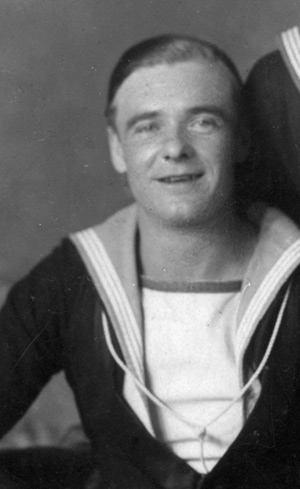
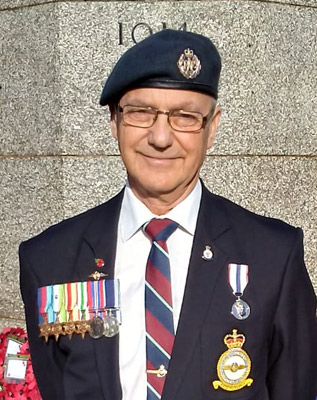 I continue to be contacted by the families of men who were saved or died on the night of 11 – 12 November 1942 when HMS Hecla was torpedoed.
I continue to be contacted by the families of men who were saved or died on the night of 11 – 12 November 1942 when HMS Hecla was torpedoed.On Remembrance Sunday Ken Johnson wears his father's medals at the war memorial in Bury where AB Herbert Johnson (left) died in 1982 sixty years after HMS Hecla was torpedoed. Note the family resemblance.
Herbert Henry Johnson was on Hecla when she was the destroyer depot ship for the Atlantic escorts at Havelfjord, Iceland, but left her on the Clyde or in South Africa, a lucky escape.
William T Fox and Thomas D.A. Waldock were both Stokers 1st Class, shared the stokers’ Mess and died together.
Denise Jefford is the grand daughter of William Fox, a family secret confirmed by a DNA test.
Jim Waldock was one year old when his elder brother was killed and is hoping to trace a photograph of him.
Petty Officer Henry Phuler Holcombe was awarded the BEM for his bravery when Hecla was mined off the tip of South Africa.
But lost his own life when Hecla was torpedoed leaving his wife a widow and a son without a father.
So many family stories are linked to the loss of HMS Hecla at midnight on 11 November 1942.
http://www.holywellhousepublishing.co.uk/crew_list-hecla.html
Lt (E) William R. Forster RNR joined Venomous during her refit at Falmouth
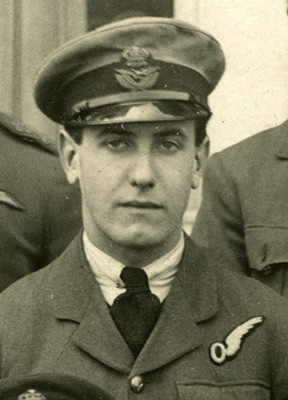 |
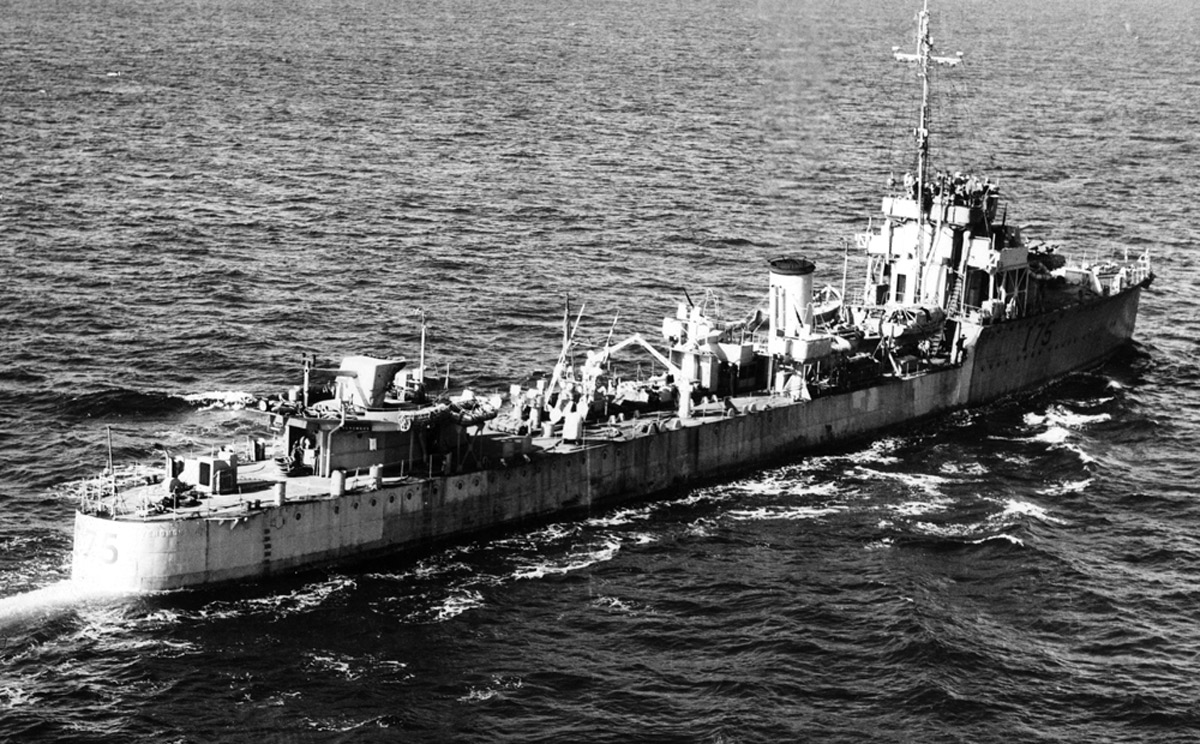 |
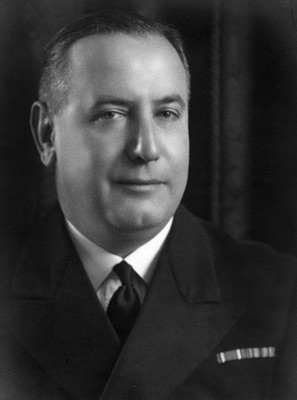 |
I visited Falmouth for the first time in September 2019 and made some unexpected discoveries about my father and the elderly V & W Class destroyer in which he served and the Eagle Oil tanker in which he went on an Arctic Convoy to Archangel in North Russia. I intend to resume work on Forty Years at Sea: a voyage with my father which I abandoned twelve years ago but I also hope that the discoveries I made in Falmouth will help other researchers as well as interest those of you with family connection to HMS Venomous - or one of her sister ships.
The Evacuation of the Guards From Boulogne
But preparations for the evacuation began at 1136 that morning when HMS Vimy landed Force Buttercup to secure the immediate port area of Boulogne and provide cover for the Naval Reserve Demolition Party once the decision was made to destroy port facilities. That operation is described by the two platoon commanders who took over when their officer, Lt James, was severely wounded. Their report accompanied by a sketch map is combined with other sources to give as accurate a description of events as we are ever likely to have. Lt Cdr Frank Donald RN (Ret) the son of Lt Cdr Colin Donald RN who was killed on the bridge of HMS Vimy by a sniper's bullet later that day has studied all the sources and describes his findings in Force Buttercup at Boulogne and links to PDFs of the document in the National Archives.
The success of Force Buttercup in securing the area prepared the way for the evacuation of the Guards by the eight V & W Class destroyers and the Flotilla Leader HMS Keith. The V & Ws were: HMS Venomous, Whitshed, Wild Swan, Windsor, Vimy, Vimiera, Venetia and HMS Verity. Brief details of the part played by each of these destroyers can be seen on this page of the website of the V & W Destroyer Association.
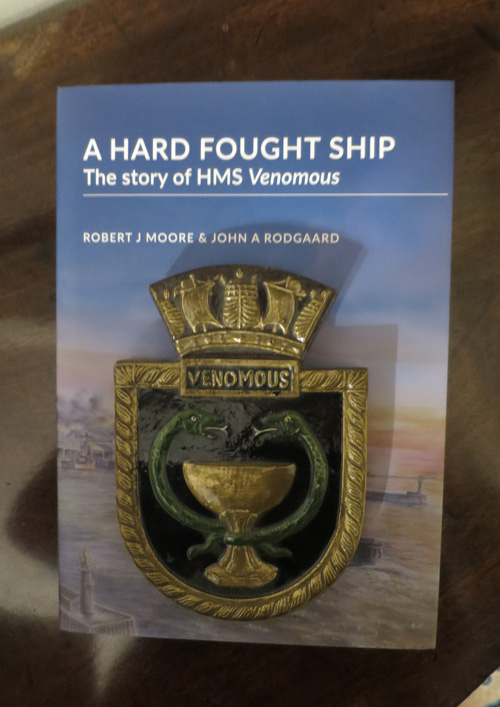 The crest of HMS Venomous on the cover of A Hard Fought Ship
Find out more about crests, plaques and tampions of warships |
This
definitive hardback edition has five new
chapters, 50,000 more words and a hundred new photographs. And the
larger format and new design gives it a completely new look.
HMS Venomous was one of 67 V & W Class destroyers built at the end of World War I. They were perhaps the most advanced detroyers in the world and arguably the most successful ever. By the end of World War II they had all been sunk or scrapped but during those thirty years thousands of men served on them as convoy escorts on the East Coast, during the Battle of the Atlantic, on arctic convoys to Russia and in the Mediteranean. The most detailed study yet of the contribution made by a typical “old warrior” of the V & W Class to winning World War II. HMS Venomous brought back the troops from Boulogne and Dunkirk, fought off the U-boat which sank HMS Hecla while rescuing 500 survivors and escorted the invasion fleet to Sicilly as well as escorting convoys to Nova Scotia, Russia and in the Mediterranean. The story of HMS Venomous is told by her officers and crew and illustrated with 258 of their photographs taken in the heat of the action plus paintings, drawings and maps. The old edition was praised by Navy News
as "an exemplary ship biography where a detailed narrative of the
destroyer's exploits are brought to life by a wealth of first hand
accounts" and described by the Naval Review "as being up in the same class as 'The Cruel Sea' for a picture of small ship life in World War 2."
A Hard Fought Ship: the story of HMS Venomous;
by
R.J. Moore and J.A. Rodgaard. Holywell House Publishing, 9 May 2017. ISBN 978-0-9559382-4-5. Hardback, £35. Order online post free in UK - £29. |
The painting on the book cover is of HMS Venomous passing the Britannia Monument as she follows HMS Wild Swan into Boulogne harbour at 2030 on the 23 May 1940.
The bronze statue of Britannia was unveiled on 19 July 1938 as King George VI entered harbour in the Royal Yacht at the start of his tour of France
and dynamited by the Germans on 1 July 1940.
The painting is by Peter K. Hsu.
Take a look at the Contents Page and List of Illustrations
Stephen J. Barney (1922-2017)
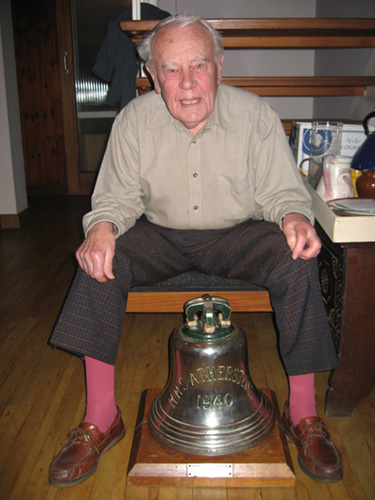 |
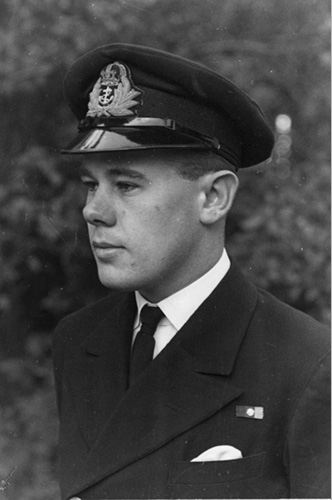 |
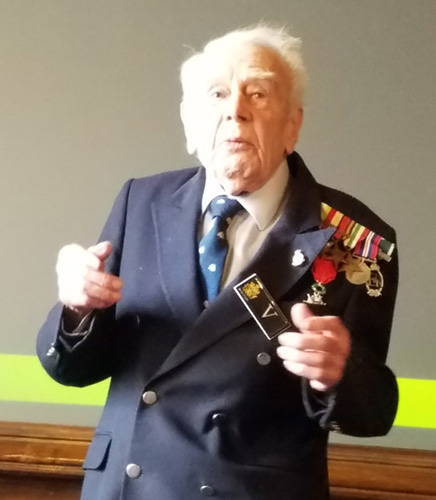 |
On the first occasion I visited him at his home he was not there and his wife explained that he had been delayed by a car accident but was unhurt. I expressed the hope that this would not shatter his self confidence and received a most peculiar look. Stephen was physically very small but had a big personality and it was difficult to imagine that anything could dent his confidence. I photographed Stephen Barney with the bell of HMS Athelstone in March 2007 before he left for the annual reunion at St Nazaire in April. We met again with Chris Eaton, the son of Lt Leslie Eaton RNVR, to look through his father's photograph album and Stephen put names to the faces. He insisted on ordering ten copies of the 2010 edition of A Hard Fought Ship in advance of publication and suggested Chris did the same. It wasn't necessary but at the time was very reassuring. He always referred to himself as Midshipman Barney and whenever I left he would stand at attention in the drive and snap a smart salute. A really delightful person and a great help while I was researching this book for my American author.
He spoke at the book launch of the new edition at the Royal College of Defence Studies in May 2017 and was photographed talking to MIchael Sangster, the son of Lt Tony Sangster RNVR, the officer he did standing watches with on HMS Venomous. Two days later I received orders from two of his fellow passengers on the train back home from London who had been charmed and thrilled by his stories. It is hard to believe that I shall not see him again.
The names of all the officers and men who served in HMS Venomous during the war on three of the most significant dates in her history are known and can be seen on this website. Most of the stories and photographs on this website were contributed by them or their families. And the names on the crew lists link to these stories. They are a name index to the website. If your family had a family member who served in Venomous check these lists to see if their names are listed and if you have stories or photographs to add to the site do get in touch by e-mailing Bill Forster.
First wartime Commission (September 1939 - November 1942)
On the 31 May 1940 - the day HMS Venomous made the first of five trips to evacuate troops from Dunkirk
Second wartime Commission (April 1942 - October 1943)
On the 12 November 1942 - the night when HMS Hecla sank and HMS Venomous rescued 500 survivors
Third wartime Commission (August 1944 - July 1945)
On the 14 May 1945 - the day when HMS Venomous arrived at Kristiansand to accept the surrender of German naval forces
When men served for a few months between these key dates they do not appear on any of these lists but we would still like to hear from you. Only three men appear on all three lists and almost certainly served throughout the war from Venomous coming out of reserve in 1939 to being paid off and decommissioned in June 1945.
The publication of A Hard Fought Ship in May has led to many new stories being sent to me by the families of the men who served in HMS Venomous or were brought back from the beaches and North Mole of Dunkirk. Terry Munro in Canada sent me a CD of the photographs and service record of his father, William Munro, Yeoman of Signals in HMS Venomous in 1940-41. William Munro enlisted as a 16 year old Boy Sailor in 1927 but was Yeoman of Signals in HMS Hood when he joined Venomous in January 1940.
Terry's father was at Boulogne when Venomous and six sister ships brought the Guards back home on 23 May. He described the man operating the twin Lewis guns on the wing of the bridge struggling to remove the empty drum magazines. They jammed, came off with a jerk, he staggered backwards hands in front of his face and a shot fired by a sniper from one of the dock cranes on the quayside hit the drums. "Dad said that the chap had seen where the shot came from, reloaded and fired at the sniper who fell from the crane being hosed with machine gun rounds all the way to the ground, and all the time the gunner was swearing at the German without repeating himself. He apparently emptied the new mags into the sniper after he hit the ground!" William Munro also served with Lt Cdr John McBeath on his next ship HMS Oribi and Munro's story is a "work in progress".
Thomas Moore has sent me some remakable photographs: "taken by my mothers first husband RAF Flt Lt Gordon Leslie MacIntyre DFC a Canadian who joined the RAF in 1939 and became a bomber pilot. During the evacuation at Dunkirk he hopped a ride on a WAIR destroyer. The photographs show this destroyer alongside the mole loading troops and underway packed with troops." As a result of some clever detective work by Frank Donald we now know that these photographs were taken aboard HMS Wolsey on the 30th May 1940. You can see the photographs and read the story behind them on the website of the V & W Destroyer Association.
The officers of the Green Howards drew lots to see who would stay behind to defend the perimeter around the North Mole at Dunkirk while their troops were boarding HMS Venomous on the night of 2 - 3 June. Private George F Wilson, Sergeant Lou Warn and Corporal Doug King were on the cordon. They expected to be left behind and become Prisoners of War but George Wilson (now aged 96) and his two friends were amongst the 1,400 - including Generals Alexander and Percival - who got aboard. His luck ran out in June 1942 when he was captured in the Western Desert and spent the rest of the war as a POW at Stalag 4C. George Wilson's story was told to me by his son Mark and you can read the story of the Green Howards at Dunkirk on my website about HMS Venomous.
The author of A Hard Fought Ship, Capt John Rodgaard USN (Ret), held the launch in the USA at a private showing of the film Dunkirk at Arlington, across the Potomac river from Washington, on the 13th August. The names of the men in Venomous when she and her sister ships brought the Guards back from Boulogne and the BEF from Dunkirk can be seen on the website. If a member of your family is on this list do get in touch and share his story with the families of his shipmates. I would also like to hear from families of the troops brought home by Venomous. My father's youngest brother, Private Alan Forster, never reached Dunkirk. His Company of the Tyneside Scottish were almost all killed or captured defending the retreat of the BEF and Alan spent five years at Stalag XXID and Stalag VIIIB in Poland.
Fred Mercer - "Proud of former deeds"
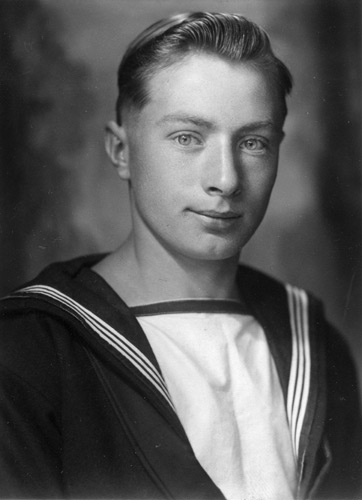
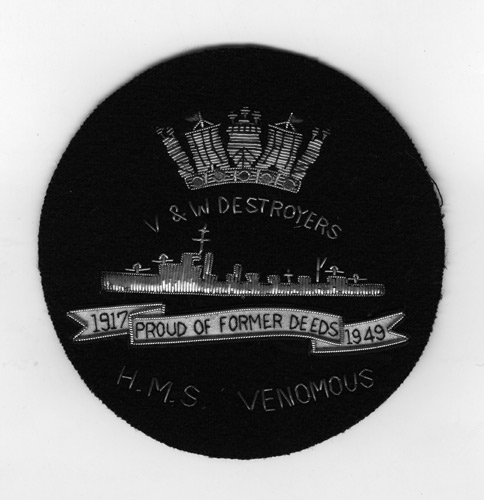 AB
Frederick Mercer (JX180531) was born in 1924 and joined the Navy
with two close friends before the outbreak of war in 1939. They were
serving together in the Prince of Wales when
she was sunk by Japanese torpedo bombers off the East Coast of Malaya
on the 10 December 1941. Fred was saved, one of his friends was killed
and the other became a POW. His next ship, HMS Cornwall,
was sunk in the Indian Ocean on 5 April 1942 and Fred was in the water
for two days before he was rescued. Fred wrote an account of this
dramatic start to his wartime service which I hope to publish on this
web site.
AB
Frederick Mercer (JX180531) was born in 1924 and joined the Navy
with two close friends before the outbreak of war in 1939. They were
serving together in the Prince of Wales when
she was sunk by Japanese torpedo bombers off the East Coast of Malaya
on the 10 December 1941. Fred was saved, one of his friends was killed
and the other became a POW. His next ship, HMS Cornwall,
was sunk in the Indian Ocean on 5 April 1942 and Fred was in the water
for two days before he was rescued. Fred wrote an account of this
dramatic start to his wartime service which I hope to publish on this
web site. He joined HMS Venomous at Falmouth in July 1944 for her final commission when she was a target ship for Barracuda torpedo bombers in the Irish Sea and later off the east coast of Scotland. Fred had another narrow escape when she was nearly lost on a lee shore in a terrible gale on 14 January 1945. Venomous survived and was fortunate to be picked by Captain(D) of the Rosyth Escort Force as one of the destroyers to be sent to the ports of entry on the west coast of Norway to accept the surrender of German naval forces. Venomous was by now stripped of her armament and no longer a fighting ship but she accompanied HMS Valorous to Kristiansand South on a fiord off the Skagerack, the channel separating Norway from Denmark.
On 15 May a surrender ceremony was held aboard Venomous for the U-boats at Marvika across the bay from Kristiansand. Fred was told to cox the ship's whaler which brought the German Admiral to the surrender ceremony. In later years he said it was the proudest moment of his life at sea when the Admiral congratulated him on his seamanship. This may perhaps explain why Fred stayed behind in Kristiansand and returned to Britain on one of the surrendered u-Boats. Fred returned to Kristiansand with twenty other Royal Navy veterans at the invitation of the Norwegian Navy on the 50th anniversary of the end of the war in 1995.
Fred Mercer stayed on in the Navy and joined the new frigate, HMS Loch Veyatie (F658) at Londonderry for duties at the Joint Anti-submarine Training School. He left the Navy in 1956 to look after his Mother when she was dying of cancer. He worked as an engineer for Reliance Systems until retirement. He was a member of the V & W Destroyer Association and attended their annual reunions until his death aged 83 in 2007.
The badge of the V & W in which members of the Association served (on right) was worn on the breast pocket of their blazers. Fred Mercer's badge for HMS Venomous was found by his widow Ann Mercer in a folder of papers relating to the V & W Destroyer Association. The dates for HMS Venomous are not quite accurate. Venomous was launched in 1918, commissioned in 1919, decommissioned in June 1945, handed over to BISCO (British Iron and Steel Corporation) for scrapping in 1947 and broken up for scrap in November 1948.
"Teddy" Weekes - lost overboard in a storm
Venomous was a lucky ship and very few of her crew lost their lives but on 8 October 1941 "Teddy" Weekes, a reservist from Oxfordshire, was washed overboard in an Atlantic storm. "Teddy" Weekes had joined the Navy as a boy sailor in 1918 and signed on for twelve years in 1920. When he was recalled at the outbreak of war in 1939 his past experience led to him being made Bosun's Mate and he was issued with the traditional Bosun's Call which he wore on a light chain round his neck and "piped" when he had a message to convey from the Quartermaster or the officer of the watch. There were certain standard "pipes" with set meanings such as "still" , a single long note used to bring hands on the upper deck to attention when saluting passing ships, and "pipe down" (eg lights out) with two high pips and a falling trill. The Call was also used for "piping the side", saluting a senior officer coming aboard or leaving.
In accordance with Naval tradition his possessions were auctioned and the money raised sent to his widow. His friend, George A. ("Arnie") Birkin, a gunlayer on “A” Gun, who joined Venomous at the same time as Teddy Weekes, made the successful bid for his bosun’s call and his son, Malcolm Birkin, who lives in South Africa still has it and sent this photograph.

Hear the veterans tell their own stories online
There are five recorded interviews with men who served on HMS Venomous in the Sound Archive of the Imperial War Museum. They include two interviews with Lt Cdr John Macbeath RN, the CO of Venomous in 1940 when she evacuated troops from Boulogne and Dunkirk. Details of these interviews appear on the web site of the V & W Destroyer Association along with interviews with veterans who served on other V & W Class destroyers made by Bill Forster at the annual reunions of the Association. In most cases the interviews can be heard online and links are provided to the recordings. Click on this link to the recorded interviews with veterans who served on Venomous and other V & Ws.
The Early Years: From the Baltic to the Red Sea, 1919-29
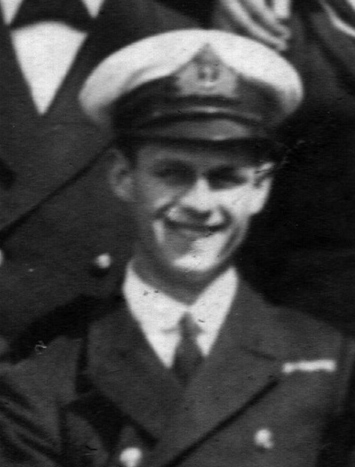
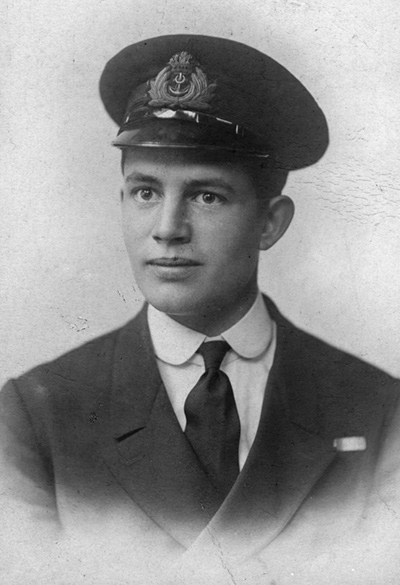 A Hard Fought Ship contains first hand accounts by some of the officers and men who served in HMS Venomous
during her first commission and were interviewed by Bob Moore in the
1980s.
A Hard Fought Ship contains first hand accounts by some of the officers and men who served in HMS Venomous
during her first commission and were interviewed by Bob Moore in the
1980s.Sub Lt Edward Hurry RN (1899-1959) on the right and Midshipman Renfrew Gotto RN (1900-82) joined HMS Venomous at the start of her first commission and took part in the Baltic campaign that winter when the sea froze and spray covererd her deck and upper works with thick ice. Renfrew Gotto's Midshipman's Journal in the IWM gives a vivid account of conditions in the Baltic. Both officers left Venomous at Chatham in January 1920. Lt S.B. de Courcy-Ireland RN (1900-2001) on the left served in Venomous from September 1920 to February 1922 and the IWM recorded a fascinating eleven reel interview in 1991 which can be listened to online over the Internet.
Even today I am occasionaly contacted by the sons of men who served in Venomous during her early years with stories or photographs for the third edition of the book which will be published in 2016 and this web site. The most recent addition is the story of Reginald Williams naval service on HMS Kent and HMS Venomous which includes a photograph of the ship's company for the first commission.
Venomous was assigned to the Mediterranean Fleet in October 1923 and Valletta became her home port for the next six years. On the 2 November 1924 as Venomous entered the Grand Harbour at Malta “she rammed and sank a motorboat from the Caledon Class light cruiser, HMS Calypso. Fortunately, all hands were saved from the warm waters” (A Hard Fought Ship, page 50). The unexpected outcome of this narrowly averted tragedy is still felt today. Read the full story.
Since publication of A Hard Fought Ship we have been contacted by the son of Lt Cdr Colin G.W. Donald RN who as a young officer in HMS Venomous in 1926-8 kept a Diary which together with his photographs sheds fresh light on what it was like to be an officer aboard a V&W Class destroyer in peacetime. His son, Frank Donald, tells his father's story.
When the balloon went up ...
After being laid up for ten years HMS Venomous was recommissioned in 1939 and spent the first months of the war escorting the requisitioned ferries taking the British Expeditionary Force (BEF) to France. As Venomous left Cherbourg at dawn on the 10 May 1940 she received the all-Fleet broadcast that Germany had invaded France and the low countries. The chapters describing the dramatic events of the next four weeks are some of the most exciting in A Hard Fought Ship.
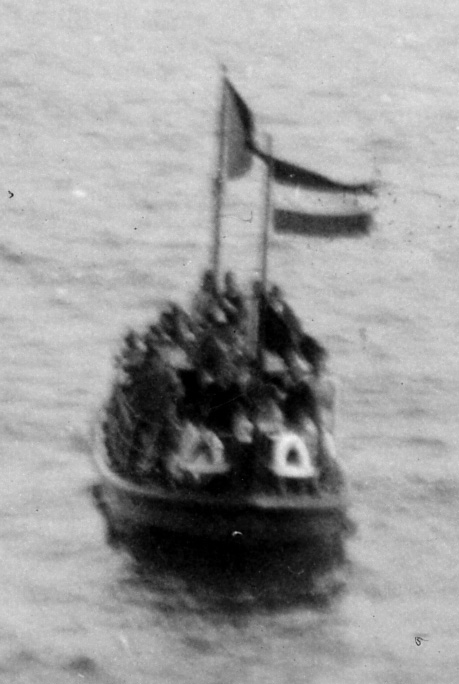
Venomous spent the first week off the Dutch coast. On the 15 May Lt Peter Kershaw RNVR photographed an overcrowded lifeboat, the Zeemanshoop, full of refugees (left) many of them Jewish, and the Dutch tug Atjeh carrying Cdr Goodenough's demolition team.
On the 21 May Venomous was sent to Calais to bring back vital equipment for detecting U-Boats from the loop induction station at Sangatte, Calais, a million pounds of platinum spinerettes from Courtaulds rayon factory and evacuated most of the British community, including 16 year old John Esslemont and his father who worked at Courtaulds.
On the 22 May she escorted the cross channel ferries taking the Welsh and Irish Guards to defend Boulogne and left the harbour with her decks crowded with children and nuns. Peter Kershaw photographed the extraordinary scene.
Venomous returned to Boulogne the following day with six other V & Ws to bring the troops back while fighting off air attacks and German tanks. Lt Cdr Colin G.W. Donald RN, a young officer in Venomous in 1926-8, commanded HMS Vimy. This was his first and last command.
There was no respite, between the 31 May and the 4 June Venomous made five trips to the beaches and North Mole of Dunkirk and brought 4,410 troops. The names of all the officers and men when she made the first of five trips to bring back the troops of the BEF from Dunkirk on the 31 May 1940 can be viewed online wth links to further details.
Detailed descriptions of these events were given by the men aboard Venomous and illustrated with their photographs in the new hardback edsition of A Hard Fought Ship which was published on 9 May 2017. For further details see this page on the web site.

The beach at the coastal resort of Bray Dunes six miles east of the Mole at Dunkirk where HMS Venomous embarked troops
The photograph was taken during the evacuation
Escape to England
On the 15 May 1940 HMS Venomous was escorting two minesweepers near the Goodwin Sands when a Dutch lifeboat was sighted making distress signals. Her deck was packed with refugees from the Netherlands who had left Scheveningen, the harbour and seaside resort for The Hague, at dusk the previous evening, the day the Netherlands surrendered. She had been hijacked by four university students and the refugees were mostly Jewish - some Dutch but others German - desperate to escape death in the Camps of Nazi Germany. They were taken aboard Venomous and landed at Dover that evening.
On 14 May 2015 a hundred men and women from three continents assembled at Scheveningen to commemorate the 75th anniversary of their rescue by the Zeemanshoop. They included one of the students, 95 year old Karel Dahmen, and a 92 year old "schoolboy", Loet Velmans. The Mayor of The Hague and the British Ambassador were there and the 90 year old Dutch lifeboat, Zeemanshoop (Seaman's Hope), newly restored took them round the harbour. The son and daughter of Lt Cdr John McBeath, the CO of HMS Venomous in May 1940, attended. And the Royal Navy sent HMS Trumpeter, the Cambridge University Royal Navy Unit's training ship, to the reunion of the families of the 46 men and women on the Zeemanshoop. Loet Velmans died on 11 November 2016.
The event received huge publicity on Dutch television and national papers and a book in Dutch was launched at the reunion. As a result of the publicity the family of another seven passengers on the Zeemanshoop have been traced and their stories told on my web site about the Zeemanshoop.
Wireless Telegraphy on Wartime Destroyers
Eric Arnold Poutney WRX2064 joined HMS Venomous as a Wireless Telegraphy Operator at Rosyth on on the 31 July 1939, the same day as Lt Cdr Donald G.F.W. McIntyre RN took command, and left at Falmouth in October 1943. He was a keen photographer and his pictures provide a vivid idea of what it was like to serve as a rating in Venomous. The copies of the signals he received and sent while Venomous was evacuating the troops from Boulogne on the 23 May 1940 and from Dunkirk on the 31 May record events as they happened. The use of Wireless Telegraphy and visual signaling is described and illustrated with his photographs.
The Battle of the Atlantic
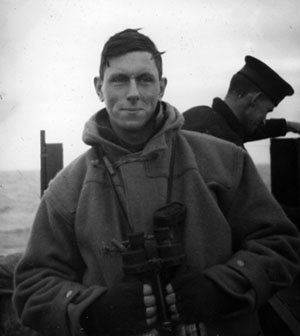
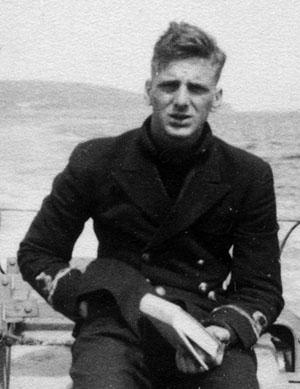 On the 18 December 1940 Venomous joined the First Escort Group at Londonderry escorting the
convoys which kept Britain from being starved into submission. Some of
the men in Venomous met their wives at Londonderry and their children still live in the town. After refuelling at Iceland Venomous occasionally rejoined the convoys and continued to the ports on Canada's Atlantic seabord.
On the 18 December 1940 Venomous joined the First Escort Group at Londonderry escorting the
convoys which kept Britain from being starved into submission. Some of
the men in Venomous met their wives at Londonderry and their children still live in the town. After refuelling at Iceland Venomous occasionally rejoined the convoys and continued to the ports on Canada's Atlantic seabord. You can see the Atlantic convoys escorted by HMS Venomous in 1940-1 and read about them in the new edition of A Hard Fought Ship which was published on 9 May 2017.
The protection of these convoys by Royal Navy and Royal Canadian Navy escorts created a link between Canada and Northern Ireland which is still maintained today. In May 2013 Canadian naval veterans celebrated the the 70th anniversary of the turning of the tide in the Battle of the Atlantic by going on a pilgrimage to Londonderry. The Sailors' Monument, a replica of the statue on the water front at Halifax, Nova Scotia, where the convoys assembled was unveiled. HMCS Sackville, the last of the 120 Canadian built corvettes which escorted the convoys is preserved in Halifax as Canada's Naval Memorial.
Lt Homer McPhee RN (1919-2006), a popular Canadian officer in HMS Venomous in 1941, transferred to the RCN after the war and retired as its longest serving officer. He shared a cabin with Sub Lt John Tucker RNR (1920-2011) on the right who described the convoy system in A Hard Fought Ship. The daughter of Lt Cdr Angus Mackenzie RNR ("Bloodie Mackenzie", see below) lives in Halifax where her father's ashes were scattered in Bedford Basin, where the convoys assembled for the Atlantic crossing.
HMS Venomous remained an Atlantic escort until April 1942 interrupted by major repairs after detonating a mine in Liverpool bay on New Year's Eve 1940 and repairs and refit after a collision with the flotilla leader, HMS Keppel, in November 1941.
The Arctic Star awarded to veterans of the Arctic Convoys to northern Russia
In April 1942 Venomous escorted Arctic Convoy PQ.15 to Murmansk and in May returning convoy QP.12. The USSR awarded the veterans of the Arctic convoys a commemorative medal on the 40th anniversary of the end of the war and in 1995 Fred Thomas, the RDF (Radar) operator on Venomous was one of fifty veterans who returned to Murmansk on the 50th anniversary. It took a long campaign by the veterans to win recognition from their own government. The award of the Arctic Star in 2013 came seventy years after the turning point in the Battle of the Atlantic in 1943 which was commemorated by events in Londonderry, Liverpool and London.
Read about their campaign, eligibility for the Arctic Star and how veterans and the families of those who served on the merchant ships and their escorts can apply.
Operation Pedestal - August 1942
A Hard Fought Ship describes how HMS Venomous twice escorted the elderly aircraft carrier HMS Furious within flying range of Malta so that its Spitfires could take off and land on the island's airfield. The officers and crew of Venomous saw HMS Eagle torpedoed, its aircraft sliding off the deck and the carrier plunging beneath the waves and took onboard its Commanding Officer, Capt L.D. MacKintosh DSC RN, 48 of its officers and 487 men. The scene was photographed from Venomous by AB Cyril Hely.
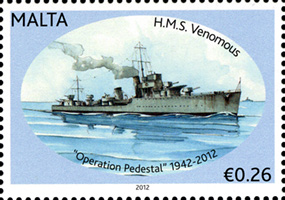
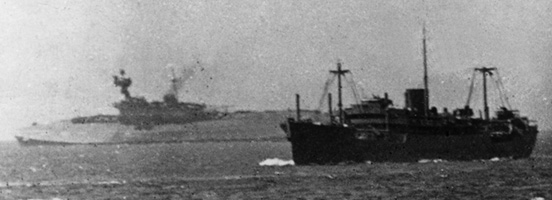 In 2012 the George Cross island of Malta celebrated the seventieth anniversary of Operation Pedestal
(the Santa Marija Convoy) which broke the German blockade of the
besieged island by issuing a set of 88 stamps each one bearing the name
of one of the allied ships. Malta stood at the cross roads between Alex
and Gib and straddling the Axis supply lines to North Africa and the
courage the islanders displayed under constant bombing during the siege
led to it being awarded the George Cross.
In 2012 the George Cross island of Malta celebrated the seventieth anniversary of Operation Pedestal
(the Santa Marija Convoy) which broke the German blockade of the
besieged island by issuing a set of 88 stamps each one bearing the name
of one of the allied ships. Malta stood at the cross roads between Alex
and Gib and straddling the Axis supply lines to North Africa and the
courage the islanders displayed under constant bombing during the siege
led to it being awarded the George Cross.HMS Venomous appears on one of the stamps (MT085) issued by the Malta Postal Service in August 2012. Single stamps and sheets of eight are no longer available but the price of a complete set is still quite modest and it includes the other V & W Class destroyers which took part in this operation which saved Malta. For details of all the ships featured on the stamps and availability of presentation packs of mint stamps (PP) and franked first day covers (FDC) with a book about Operation Pedestal visit the online shop of Malta Post.
HMS Hecla sank on Armistice Day 1942
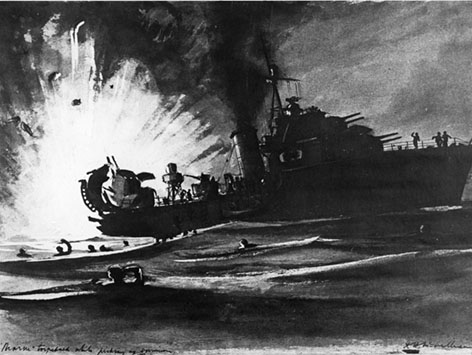
There were 799 ratings and 39 officers aboard the destroyer depot ship, HMS Hecla, when it was torpedoed off the coast of Morocco on 11 November 1942, Armistice Day.
556 were rescued, twelve killed and 273 reported "missing presumed killed". HMS Marne rescued 64 before a torpedo blew off its stern (left) but the vast majority, 493, were saved by HMS Venomous despite having to break off its rescue to attack the German U-boat.
The description of that long night in A Hard Fought Ship is the most detailed yet written and will probably never be superseded. The photographs of Lt Leslie Eaton and AB Cyril Hely on Venomous and the paintings of Herbert McWilliams, done within a week of his rescue, are combined with memories of the officers and men on Venomous and the stories told by the survivors of HMS Hecla. These include Herbert McWilliams, Fred Lemberg, Norman Johns, George Male, Edward Coleman, Les Rowles, Fred Woods and Greg Clarke.
You can find out more about the loss of HMS Hecla by clicking on the link above but for the full story of events leading up to the disaster and the battle by Venomous to save the survivors struggling in the water while fighting the attacking U-boat you should read the new much expanded hardback edition of A Hard Fought Ship published in May 2017.
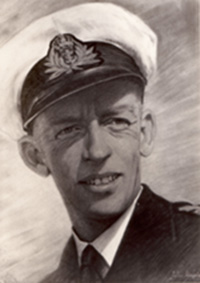 War at Sea - in words and pictures
War at Sea - in words and pictures
Herbert Hastings McWilliams, a South African architect, talented artist and passionate sailor, enlisted as an ordinary seaman in
1941 and served in HMS Shropshire. After being commissioned he served in motor launches and MTB with Coastal Command at Lowestoft before joining HMS Hecla at Simon's Town on the 4 September 1942, two short months before it was torpedoed off the coast of north Africa.
Mediterranean Escort
In 1943 HMS Venomous escorted the first through convoy from Gib to to Alex after the surrender of Axis forces in North Africa and escorted the troop carriers from Alexandria to the landing beaches in Sicily. For most of this period her CO was Lt Henry D. Durell RN who was killed while commanding HMS Isis at the Normany landings in June 1944. The sons of several of the men who served on Venomous during this period have contributed family stories and photographs to the web site. They include Jack Bolton, Bob Hargreaves, David Hoggins and George Wilson. See the details and links given below under the heading, "The Officers and men who served on Venomous".
The Liberation of Norway in May 1945: Operation Apostle
Eight destroyers in the Rosyth Escort Force were selected to take part in Operation Apostle, the surrender of German naval forces at at Kristiansand, Bergen, Stavanger and Trondheim. The commanding officers of HMS Venomous, Lt Cdr A.G. Prideaux RNVR, and HMS Valorous, Lt J A J Dennis DSC RN, both left descriptions of their part in this last operation of the naval war in Europe which can be read on this web site. And Miroslav, Stanley Lansky, the last surviving officer in HMS Venomous at the surrender of the German U-Boats in Kristiansand died in Geneva on the 15 July 2014 and his family have helped me tell his story.
The Commanding Officers of HMS Venomous
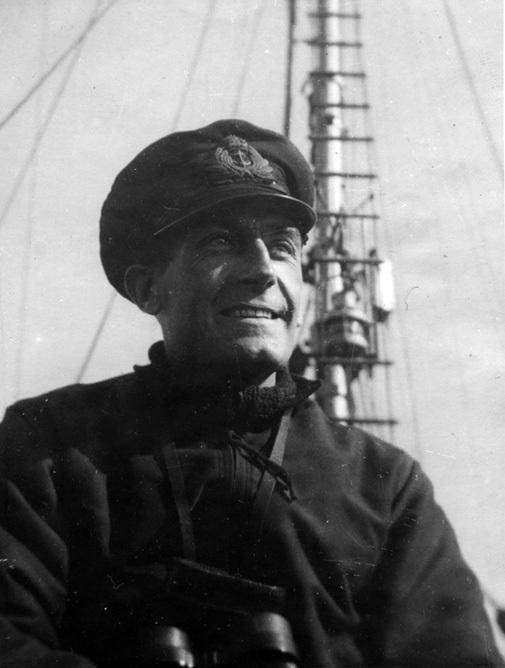
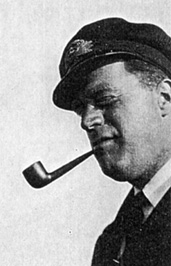 These brief pen portraits of the nine wartime commanding officers of HMS Venomous will link to more detailed descriptions of their lives and wartime
service but only the pages about David Maitland-Makgill-Crichton (1910-87) and the last two COs of HMS Venomous, Lt Cdr A. Derek A. Lawson RNVR (left) and Lt Cdr A.Guyon Prideaux RNVR (right), have been completed.
These brief pen portraits of the nine wartime commanding officers of HMS Venomous will link to more detailed descriptions of their lives and wartime
service but only the pages about David Maitland-Makgill-Crichton (1910-87) and the last two COs of HMS Venomous, Lt Cdr A. Derek A. Lawson RNVR (left) and Lt Cdr A.Guyon Prideaux RNVR (right), have been completed.The names of all the officers and most of the ratings who served in HMS Venomous between 1919 and 1946 are recorded on this web site. They tell the story of the ship in which they served in the pages of A Hard Fought Ship but since its publication in 2010 the families of many more have contributed stories and photographs to this web site about HMS Venomous. You can read about some of them below.
The daughters of Eric Pountney, the wireless operator on Venomous from 1939 to October 1943, have sent me their father's service record and some wonderful wartime photographs taken aboard the ship. If you have stories to tell - or photographs to scan - do get in touch.
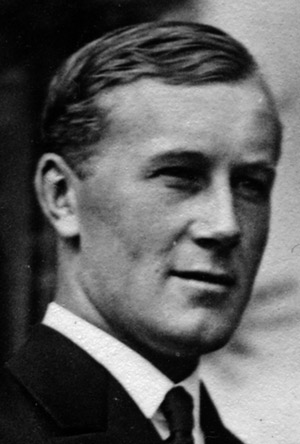
 Death of a centenarian, Cdr D.A.R. Duff RN, "No 1" to Lt Cdr D.G.F.W. Macintyre RN in 1940
Death of a centenarian, Cdr D.A.R. Duff RN, "No 1" to Lt Cdr D.G.F.W. Macintyre RN in 1940At the outbreak of war HMS Venomous was commanded by Lt Cdr Donald G.F.W. Macintyre RN and his "No 1" was Lt D.A.R. Duff RN "a tall man with a quiet assured air" (left) who was called Dan by his friends and fellow officers. Lt Duff did not serve on Venomous for long but he went on to have a long and distinguished naval career and retired as Cdr Daniel Alexander [Wyatt] Rawson Duff RN. He served in HMS Manchester, was torpedoed twice and when she sank he was imprisoned by the Vichy French in North Africa. He was in the POW camp until the Allied landings in North Africa when he was released. He died on the 19 August less than two weeks after celebrating his hundredth birthday on the 3 August 2012. A short outline of the life and naval career of Cdr Duff can be seen on this web site.
Cdr Duff is not the only centenarian to have served on HMS Venomous. Lt Stanley B. de Courcy-Ireland RN (right) was born in 1900, served in Venomous for six months in 1920-1 and died in 2001. He commanded HMS Ajax (1946-8) and retired as a Captain in 1951. The IWM recorded a fascinating eleven reel interview with him in 1991 which can be listened to online over the Internet. His memoir, A Naval Life was published by his son, Capt Garth de Courcy-Ireland RN (Rtd), in 1990.
"Bloodie" Mackenzie
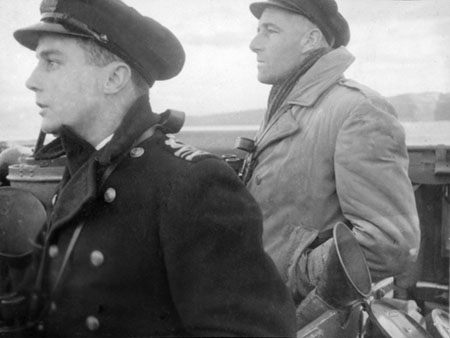
Lt Angus A Mackenzie RNR was “No. 1” on HMS Venomous to Lt Cdr John McBeath RN in May 1940 (Mackenzie is on the left with McBeath on the right in Lt Peter Kershaw's photograph). He was an outspoken officer known by his fellow officers as “Bloodie” Mackenzie but John McBeath recognised his seamanship and powers of leadership.
Venomous evacuated the Welsh and Irish Guards from Boulogne and helped bring back the BEF from Dunkirk and Mackenzie was twice Mentioned in Dispatches (MID) and promoted to Lt Cdr before leaving Venomous to take command of HMS Vimiera in February 1941.
A Hard Fought Ship covers the ten months he served on Venomous but his daughter, Sheena Mackenzie, has helped me give on this web site a more rounded picture of the wartime service and post-war business career of an extraordinary man.
HMS "Verminous"
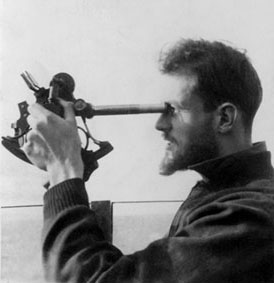
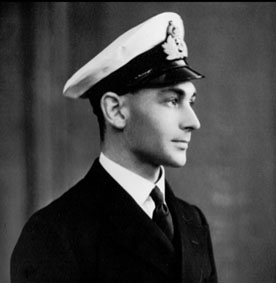 David Durell was one year old when his father Lt Cdr Henry Dumaresq
Durell RN was killed along with most of the ship's company when HMS Isis hit a mine off the Normandy
beaches on the 20 July 1944.
David Durell was one year old when his father Lt Cdr Henry Dumaresq
Durell RN was killed along with most of the ship's company when HMS Isis hit a mine off the Normandy
beaches on the 20 July 1944. As Lt Henry D. Durell (left) he was CO of HMS Venomous from February to October 1943 but we had no photographs of him in the book which was already with the designer. The memorial to HMS Isis in Portsmouth cathedral led to the HMS Isis Survivors Association and via a member to David Durell and his wife Penny in a remote part of South West Ireland without broadband.
The amusing light hearted sketch of HMS "Verminous" was presented to his father in June 1943 and Penny arranged for a photographer friend, Sue Money, to take a brilliant high resolution colour photograph and e-mail it to me over her broadband connection. Penny identified the artist (right) and traced his family. See the painting and read the story behind it.
The man in the green beret
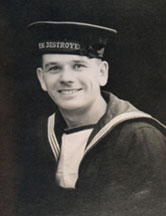
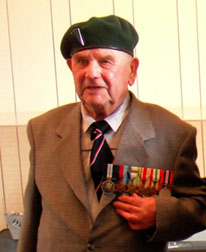 Sydney
Compston volunteered for the Royal Navy in November 1939 and was accepted just
before he received his call-up papers for the local infantry
regiment. After initial training at HMS Drake in Devonport, Plymouth, he was posted to HMS Venomous and remained aboard until its refit at Troon following the collision with HMS Keppel in December 1941. He was aboard during the action at Boulogne when Venomous evacuated the Welsh and Irish Guards on the 23 May 1940 and on the five trips Venomous
made to the East Mole and beaches at Dunkirk where from his post at B
Gun he saw General Alexander, the commanding officer of the BEF, on the
open bridge.
Sydney
Compston volunteered for the Royal Navy in November 1939 and was accepted just
before he received his call-up papers for the local infantry
regiment. After initial training at HMS Drake in Devonport, Plymouth, he was posted to HMS Venomous and remained aboard until its refit at Troon following the collision with HMS Keppel in December 1941. He was aboard during the action at Boulogne when Venomous evacuated the Welsh and Irish Guards on the 23 May 1940 and on the five trips Venomous
made to the East Mole and beaches at Dunkirk where from his post at B
Gun he saw General Alexander, the commanding officer of the BEF, on the
open bridge. Sydney's memory of his time in Venomous was exceptionally good and he made a very significant contribution to A Hard Fought Ship. He described the fitting of ASDIC during the refit at Portsmouth in 1940 and contrasted this modern technology to detect U-boats with the cutlasses which in the tradition of Nelson's navy were stored ready for use. His name crops up repeatedly in the index and he recalled many incidents for the book and the names of shipmates for adding to the list of ratings.
Venomous as a Mediterranean escort 1942-3
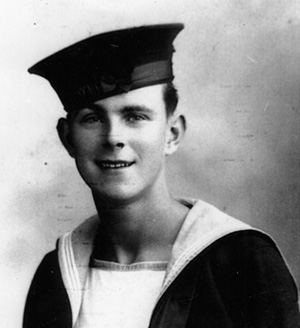
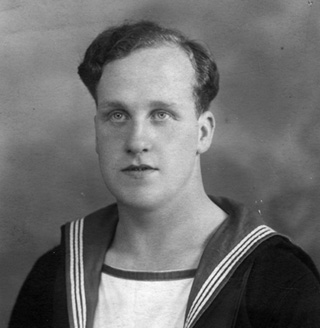
I occasionally receive orders for A Hard Fought Ship from relatives of the men who served in HMS Venomous and this often leads to new information about events described in the book.
Ray Bolton bought a copy for his father, Jack Bolton (on right), who is now 92 but was only 19 when he joined HMS Venomous at Londonderry in June 1942. Linda Atkinson bought the book for her uncle, Chris Hargreaves, the youngest brother of Bob Hargreaves (left) who joined Venomous at Troon in March of 1942. Sadly, Bob died a few months ago but Chris has recalled some of the stories he told during his final illness. George Wilson was the Asdic operator on HMS Venomous when HMS Hecla sank and in the Mediterranean. His grandson, Andrew Wilson, tells his story.
From the Arctic to Alexandria
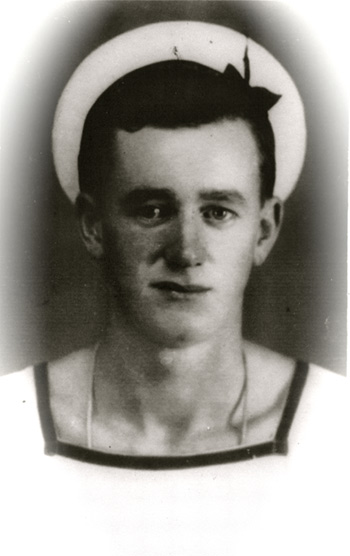
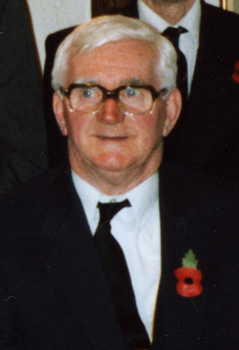
After the collision with HMS Keppel in November 1941 Venomous was towed to Troon on the west coast of Scotland for repair and a major refit during which most of its officers and crew were replaced. Only Cdr Hugh Falcon-Steward RN, its CO, and a few of its senior POs and the RDF operator, Fred Thomas, remained from her first wartime commission. Her second commission which began in April 1942 would take her from Murmansk in Arctic Russia to Alexandria in Egypt and only ended, "her engine shot", at Falmouth in October 1943.
David Hoggins was 19 years old when he joined HMS Venomous at Troon as a gun layer at the start of its second commission in April 1942. An exciting eighteen months lay ahead during which Venomous would rescue several hundred men from the destroyer depot ship, HMS Hecla, when it was torpedoed off the coast of North Africa.
David told the story of his wartime service in Venomous to his son Paul who accompanied him to the fiftieth anniversary reunion of the survivors of the Hecla at Stratford in 1992 (on right). Paul sent me the wartime photographs of his shipmates which accompany his father's memories of his time on Venomous on this web site.
Miroslav S. Lansky
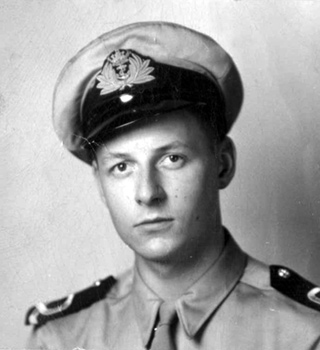
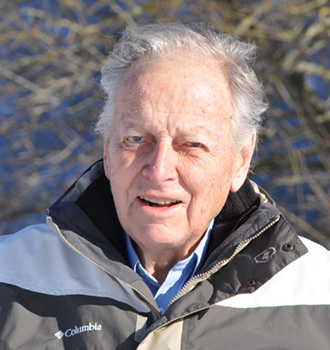 On the 12 May 1945 HMS Venomous left Rosyth with Lt Cdr A.G. Prideaux RNVR in command and with a young sub lieutenant who could speak both German and Russian aboard. Venomous and its sister ship, HMS Valorous, were being sent to accept the surrender of German naval forces at Kristiansand South in Norway, as part of Operation Apostle.
On the 12 May 1945 HMS Venomous left Rosyth with Lt Cdr A.G. Prideaux RNVR in command and with a young sub lieutenant who could speak both German and Russian aboard. Venomous and its sister ship, HMS Valorous, were being sent to accept the surrender of German naval forces at Kristiansand South in Norway, as part of Operation Apostle. Miroslav Stanley Lansky was born in London but his parents were from Czechoslovakia and registered as aliens. He grew up speaking Czech and German as well as English and on matriculating from Rye Grammar School tried to join the RAF and then the Royal Navy but was deferred until he was eighteen. After a term at Oxford he went to HMS Ganges and joined HMS Norfolk as a rating in time to take part in the Battle of North Cape when the Scharnhorst was sunk. After officer training Midshipman Lansky was posted to HMS Cassandra escorting Arctic convoys and when her bow was blown off by a torpedo on the 11 December 1944 he was stranded in Murmansk for several weeks and picked up Russian.
He joined HMS Venomous in February 1945 and was the last officer alive who was on HMS Cassandra when it was torpedoed and on HMS Venomous at the surrender of German naval forces in Kristiansand in May 1945. He worked as a translator for the United Nations in New York, Bangkok and Geneva and lived in France and died in Geneva hospital on the 15 July 2014 at the age of 89. Although he spent most of his life abroad he retained his British nationality to the time of his death. His wife and daughter have helped me tell his story on this web site.
Life on the lower deck of HMS Venomous
Frederick N.G. Thomas, the RDF Operator on HMS Venomous from June 1940 to October 1943, wrote a vivid first hand account of life on the lower deck of a wartime destroyer based on his three years as the RDF Operator in HMS Venomous. The position of the RDF compartment on the highest point of the ship made him well placed to write a vivid description of the torpedoing of HMS Hecla on Armistice Day 1942 and the rescue of five hundred survivors. Both featured prominently in A Hard Fought Ship along with the photographs he took on his Ensign box camera and are now published in full for the first time on this web site along with brief details of his life. "Freddo" died on the 9 May 2012.
"Paint ship" - artists at sea

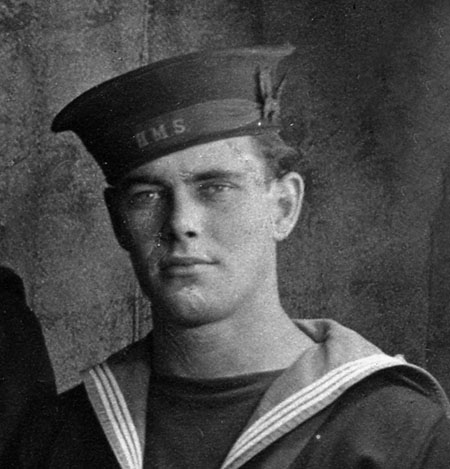
The names of five marine artists are associated with HMS Venomous. Only one AB Robert T. Back (right) served in the ship and, sadly, non of his paintings of Venomous have been traced but he is perhaps the best known today - but not for his wartime pictures.
In my view the most talented of the five was the South African, Lt Herbert H. McWilliams SANF (left) who was in HMS Hecla when she was torpedoed and was rescued by Venomous. His paintings of Hecla sinking done within days of his rescue on the back of old charts are now in the Imperial War Museum, London, and illustrate his wartime letters.
LSA Donald Preece was also in Hecla but died that night. His shipmates commissioned his cartoons of Navy life and sent them home with letters to their families. Lt C.R.V. Holt RNVR was serving in HMS Velox, a sister ship of Venomous, when he drew the amusing but accurate caricature of Venomous in June 1943 and signed it with his initial CRVH. Cdr Eric E.C. Tufnell RN was commissioned by Lt Cdr Angus A Mackenzie RNR to paint four of the five ship in which he served: HMS Hood, HMS Venomous, HMS Liddesdale and HMS Undaunted. The exception being HMS Vimiera which sank in the Thames estuary after detonating a mine with heavy loss of life (Mackenzie was one of fourteen survivors).
The photographs in A Hard Fought Ship
The taking of photographs was indeed strictly forbidden but the rules were not enforced, at least on Venomous, and the officers were generally the worst offenders. We have about 300 photographs taken on the ship and 170 are in the book. They were taken by Lt Peter Kershaw RNVR (1939-41), The Wireless Telegraphy Operator, Eric Arnold Poutney (1939-43), AB “Freddo” Thomas, the RDF operator (1940-3), Lt Leslie Eaton (1942-3), AB Cyril Hely (1942-3) and others.
Some of the photographs taken by Lt Peter Kershaw RNVR on Venomous between 1939-41 appear on this web site as well as in the book. After the war he named several of the tied houses owned by the family brewery after the ships on which he served. Sadly - but sensibly - non were named after HMS Venomous.
Frederick Norman Gwyn Thomas, "Freddo", joined Venomous in August 1940 and was over 90 when he died. He had an Ensign box camera and "a good friend on board had exactly the same camera as mine. All the snapshots of me were taken by him." He had his film developed and printed ashore. They were told never to photograph the RDF aerial, guns or torpedo launcher and all photographs were to be shown to an officer and stamped on the reverse. Neither rule was strictly enforced. Freddo remember how on one occasion he left an envelope of photographs with an officer and it was returned unopened.
Since publication many more photographs have been lent for scanning including photographs taken by Cyril Hely, whose wife gave him a camera on his 21st birthday shortly before he joined Venomous, and George Wilson, the ASDIC operator in Venomous when HMS Hecla was torpedoed..
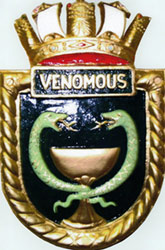 TS VENOMOUS, THE SEA CADET CORPS UNIT AT LOUGHBOROUGH
TS VENOMOUS, THE SEA CADET CORPS UNIT AT LOUGHBOROUGHHMS Venomous was broken up for scrap at Charlestown on the Firth of Forth in 1948 but its name has been kept alive by the Sea Cadet Unit in Loughborough, TS Venomous, which received its commissioning pennant that year. Bob Moore, co-author of A Hard Fought Ship, was the CO of TS Venomous from 1990 to 2003.
Tragically, TS Venomous was totally destroyed by fire on the 5 February 2012, exactly 70 years to the day after Loughborough raised the money to adopt HMS Venomous during Warship Week. The ship’s crest (see right) and the bronze plaque presented to Venomous to commemorate her adoption were both destroyed. The cost of rebuilding TS Venomous will be £250,000. Can you help?
Contribute your family's stories and photographs to this website
If you have photographs,
letters home, a diary or a journal of a family member
who served in HMS Venomous please get in touch.
Follow
in the wake of HMS Venomous
on this web site
If a member of your family served on
HMS Venomous check the list
of officers
and ratings
The story of HMS Venomous is told by Bob Moore and Captain John Rodgaard USN (Ret) in
A Hard Fought Ship
Buy the new hardback edition online for £35 post free in the UK
Take a look at the Contents Page and List of Illustrations

http://holywellhousepublishing.co.uk
Telephone: +44 1727 838595
contact online






